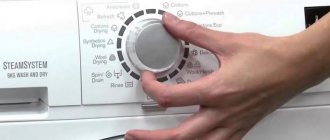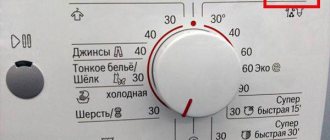Depending on the mode, washing can last from 15-30 minutes to 1-2.5 hours. It is also normal that the washing machine does not turn off 5 minutes after the start of washing. But when you set a program for 30 minutes, and the washing machine continues the process for more than 2 hours, this is not normal. In this situation, it is important to understand why the washing machine continues to wash much longer than it should according to the regime. In this article, we examined the eight most common reasons.
Fault table
| Symptoms of malfunction | Possible reason |
| The washing machine takes a long time to distribute the laundry through the drum, which increases the washing time | In this case there are no breakdowns - this is an overload of the drum. You just need to take out the excess laundry |
| It takes a long time for water to fill the washing machine, which causes the washing time to decrease significantly | 1. The valve on the water supply hose is not fully open, or the hose is squashed somewhere. 2. The filter on the inlet valve is clogged, so water is drawn in very slowly 3. Malfunction of the water supply valve. |
| Draining water after washing is very slow, so the process time increases | 1. There is a possibility that the machine was not connected to the sewer correctly and the water is slowly draining. The drain may be clogged. 2. The water level sensor is broken, and the machine simply does not understand that a sufficient amount has been collected. 3. The inlet valve is clogged with debris or broken. |
| The washing machine takes a long time to heat the water, so the washing time increases | 1. A lot of scale has appeared on the heating element, so its heating capacity has decreased and the washing time will gradually increase. 2.The thermostat sensor, which is responsible for controlling the water temperature, is not working correctly. |
| During the heating phase, the washing machine stops the washing process | The reason may be the failure of the heating element - it burns out and the machine displays an error. |
| During the process, the machine begins to “freeze” and then begins to wash again. | The electronic module works intermittently.. |
Features of the problem
A washing machine is a rather complex unit. It works according to a clear scheme, which is established by the program. To understand the situation more clearly, it is necessary to determine all the specifics of how this technique works. The user selects the program he needs, then the washing machine executes the command and monitors the process. If any deviation from the set parameters occurs, the electronic unit determines the failure of any program. Washing time increases.
The washing period takes from 30 minutes to 2 hours and depends on the selected program. It may often mistakenly seem that the process has taken a long time. First of all, you need to make sure that you have selected a standard program that does not require additional soaking and rinsing. In order to be completely sure that the equipment is faulty, you need to run some program and observe. This tactic will allow you to understand at what stage the malfunction appeared.
Note! In addition to the fact that the machine washes for longer than the stated time, the transition to rinsing and spinning may not occur.
Washing machine overload
If you put more laundry in the drum than is written in the instructions, then it will be very difficult for your unit to distribute it evenly and gain the required speed, while the machine will constantly make a constant effort, and the housewife will feel like the laundry is being washed, but very slowly. Laundry stacked in a lump can also cause prolonged distribution on the drum.
The problem can be solved simply - try running the wash with less laundry.
See also -
Electrolux washing machine displays error E40 - what does it mean?
Long rotation or immobility of the drum
The reason for the decrease in washing efficiency in an indirect drive AGR may be the belt. It tends to wear out, and this leads to its slipping on the drum pulley or breakage - then the actuator does not rotate at all. Other reasons for long washing times due to the laundry washing chamber:
- damage to the electronic control unit;
- blocking the drum with a foreign object caught in the gap between it and the machine tank;
- breakdown of the SMA drive motor;
- insufficient motor power to initially spin the drum.
The last reason appears on machine models that do not have the function of controlling the imbalance and weight of the laundry. The resulting overload and uneven distribution of things in the drum is eliminated by repacking them in smaller quantities.
honeycomb drum
Problems with water supply
The wash does not start because the washer is unable to collect the required amount of liquid. The process takes longer. There are several reasons why this problem may occur:
- There is low pressure in the water supply pipes. If this is the case, then washing should be postponed for a while until the pressure is normal;
- The taps are not fully open. You just need to check and fully open the tap that goes to the washing machine;
- the filter mesh on the inlet valve is very clogged. In this case, it is necessary to clean the filter or replace it with a new one;
- The water inlet valve has failed and will have to be replaced.
When you can solve the problem yourself
Sometimes the reasons why SMA wears off for an unusually long time lie on the surface, and you can deal with them yourself. Before calling a technician, check the following.
- Is the water pressure in the water supply normal? Open the tap and check the water pressure. If it is too weak, the machine will draw water slowly and the entire cycle will be longer. Contact the management company to normalize the water supply.
- Is the water supply valve fully open? Perhaps one of the household members blocked or did not fully open the water supply valve to the machine. Check and, if necessary, open it fully.
- Is the inlet hose squashed or kinked? Something may have fallen on the hose or it may be kinked. In this case, the SMA will take a long time to collect water, and the wash will last longer than the specified time. Release or straighten the hose.
- Is the intake valve filter clean? There is a filter mesh on the water supply valve: it protects the machine from large impurities in the water. If the mesh is clogged, water will pour in slowly and the cycle will take longer. You need to remove the filter and clean it. How to do this - read here.
- Is the drain filter clogged? The water from the tank is filtered before entering the drain pump. This design helps extend the life of the sump pump. The drain filter must be cleaned periodically. If you haven't done this in a long time, it could be clogged, causing the machine to fail to drain the water in the given amount of time and causing the wash to take longer. Read this article to learn how to clean the drain filter.
- Is the heating element overgrown with scale? As the SMA operates, the heating element becomes overgrown with scale, which reduces its heating performance. Heating the water takes longer than necessary, and the entire cycle is lengthened. If you have been using your machine for a long time and have not cleaned the heating element, find out how to do it safely from our material “How to descale a washing machine.”
- Have you overloaded your washing machine? If you have exceeded the laundry quota, the SMA will not be able to spin things out properly: the drum will spin for a long time, but will not be able to reach high speeds. In this case, the wash often ends with wet laundry. It is necessary to remove some of the items from the washing machine and restart the spin cycle.
- Is there any imbalance in the drum? If you are washing one large item (or if the rest of the laundry is stuffed into one item, for example, a duvet cover), the machine cannot distribute the items evenly on the drum, spins it for a long time, but, as a result, never reaches the required speed. Therefore, the wash ends with damp laundry. It is necessary to manually distribute the items into the drum and turn on the spin cycle.
- Is your SMA drain connected correctly? If you recently installed your washing machine, it may have been done incorrectly. If the drain hose is completely below the level of the tank, the water flows by gravity into the sewer. In this case, the machine constantly draws water, heats it again, and the cycle lasts longer than expected. It is necessary to organize the drainage correctly: lift the hose yourself or call a specialist to properly install the washing machine .
None of the options are similar to yours? Alas, then the reason that the machine takes a long time to wash is because it is broken.
Slowly drains water (stuck on drain)
The washing process may take longer if the water drains from the machine very slowly. This may cause long washing times. We check the nodes and elements of the drain:
- we check and clean the drain filter, which is located at the bottom of the front panel of the washing machine, read how to drain the water from the washing machine.
- check whether the impeller is spinning;
- clean the pipe that is attached to the pump. Disconnect the washing machine from the electricity and turn off the water. Carefully place it on its side so that the drain pump is accessible. Then we loosen the pipe clamp; if there is a blockage, we clean it and install it back;
- We check the drain hose, perhaps it is clogged. Clean it or install a new one.
See also -
Why do all the indicators on the Indesit washing machine blink?
Clogged drain hose, filter, pipe
When using the machine fully, it is possible that small parts may get into the drain hole. “Indesit” takes a long time to wash, because foreign objects (pins, coins, decorative parts, underwires from a bra, buttons, hair or threads) form a blockage, which interferes with the outflow of water from the drum. Small debris may accumulate in the drain filter, spigot, or drain hose.
If the automatic machine takes a long time to wash due to a blockage, you need to open the valve at the bottom and remove the drain filter. If debris is found on the filtration grid, remove small objects and wash the plate to remove any adhering fibers. But if the pipe is clogged with debris, then it is better to trust the technician, who will turn off the power to the device and turn the machine on its side. This will provide unobstructed access to the drain pump. The fastening clamp on the pipe and the pump should be loosened, which will allow the pipe to be removed and cleaned of foreign objects. After cleaning, the pipe is installed in place. One of the reasons why the machine takes longer to wash could be a clog in the drain hose. As a result of numerous washes, dirt settles on its walls, impairing the permeability of the liquid being removed. A smart solution would be to replace the hose.
Constantly collects and drains water: the washing process does not start
If there is good pressure in the system, you have cleaned all the filters and the pump is running, but water is drawn in and immediately leaves, there are two reasons for this:
The washing machine is not connected correctly
If the connection to the drain is incorrect, the following happens - water accumulates to a certain level and begins to go into the sewer. As a result, the required amount of liquid does not enter the machine - the wash does not start. You need to raise the hose 60 cm from the floor. Many models have a mount on the back wall into which the hose snaps into place. Check the position of the drain hose relative to the level of the washing machine.
The pressure switch is faulty
Pressostat is a sensor indicating the water level. His task is to give a command to the machine that it is time to start washing when there is enough water in the tank. If it fails, then the unit does not understand whether enough fluid has accumulated or whether it is there at all. The process will be endless - if the tank is full, water flows into the sewer, and the machine will begin to draw water again. This problem can be corrected by simply replacing the water level sensor.
Intake valve malfunctions
With this breakdown, the valve may work intermittently - not open completely, or even freeze. The problem can be solved by replacing it with a new one.
Incorrect sewer connection
Improper installation can cause the washing machine to take a long time to wash. When installing new equipment or moving old equipment, you can make mistakes that will immediately make themselves felt after launch. Violation of the connection diagram will provoke self-draining, when a full drum is emptied into the sewer. The relay sends a signal to add water, which makes it impossible to heat the liquid to the set temperature. In this case, the Indesit washing machine will take a long time to wash. The way out of this situation is to correctly connect the unit to the sewer. The drain hose must be raised to the permitted level - at least 50 cm from the floor surface. The best solution would be to install a siphon to prevent gravity flow.
Malfunctions of water heating (heating element, thermostat)
This group of reasons occurs very often - serious breakdowns requiring specialist intervention. Various parts will have to be repaired or replaced. In this case, the water takes much longer to heat up, which means the washing process increases.
Scale has formed on the heating element - it takes a long time to heat the water
Of course, the breakdown is not as global as shown in advertising, but the quality of the water leaves much to be desired and over time scale appears on the heating element. The first sign is a gradual increase in the water heating time. Try cleaning the machine with a special anti-scale agent or citric acid. If after this no changes occur, then you will have to change the heating element, or remove it and clean it manually.
Freezes at the water heating stage (heating element burnt out) - the washing machine freezes while heating the water
Usually, with this breakdown, the washing machine does not even start to spin the drum, and the corresponding error code is displayed on the display. In this case, you need to replace the heating element with a new one. Be sure to check the heating element with a multimeter before replacing.
Thermostat is faulty
In this case, there is no information that the water has heated to the required temperature, since the sensor cannot detect it. As a result, the wash either does not start or continues for a long time, since the “brain” of the machine decides that it needs a little more time to heat the water. The unit can wash for a very long time - waiting until the temperature reaches the desired level. We check the thermostat, if there is a problem, replace it with a new one.
Do I need to call a professional for repairs?
Without a technician, you will not be able to fix internal problems with your washing machine. If external causes are quite amenable to your independent verification and can be eliminated, then breakdowns inside the equipment can only be determined by a professional, a service center specialist.
Professional diagnostics and repair of a washing machine require an understanding of its structure and the interaction of its parts. If you do not have knowledge and skills in this area, then any actions will be useless and sometimes destructive. You will disassemble the machine, will not find the causes of the malfunction, perhaps replace the wrong parts and will not be able to start it. You can't save money this way.
The cost of repairing a washing machine depends on the type and number of spare parts that will have to be replaced. In most models of modern technology, only block repairs are provided - the faulty part is removed and a new one is installed in its place. Are you sure you have the right part? Substandard and used parts will only harm the car. If you install a part that is not specified by the manufacturer as recommended, there will be no effect.
Call a technician from the service center, who will carry out the work professionally and provide you with quality guarantees.
Problem with the control module or programmer (the drum spins for a long time or freezes)
If the control module fails, the machine begins to set programs incorrectly, or turns them on one after another, or simply does not turn on. In this case, the washing continues indefinitely or stops right in the middle of the process. You won't be able to solve this problem on your own. Only a specialist will be able to determine whether the module can be repaired; it may require a complete replacement.
What can be done
Depending on the specific identified cause of the washing machine malfunction, the necessary measures should be taken in time to eliminate it.
Most problems can be fixed on your own if you pay attention to them in time and do not start the process. Otherwise, if you do not solve the problem in a timely manner, it may lead to breakdown, and then the machine will have to be taken to a service center for qualified repairs.
Check the pressure in the pipes
First things first, if you find that your washing machine is running slowly, check the pressure in the water pipes. It is possible that water slowly flows into the device not because of its breakdown, but because of a malfunction in the water supply system. The faster water is drawn into the device, the faster the washing and rinsing process starts. This is especially true if the pipes in your home have not been replaced for a long time.
Checking the machine for blockages
Blockages are one of the most common causes of device malfunctions. Blockages can be mechanical, when small foreign objects get inside, or natural, when dirt accumulates inside the device, which, in turn, slows down operation.
To clear the blockages, you need to disassemble the device and carefully inspect the filtration and drainage system, pumps, siphon, then remove any detected contamination, reassemble the machine and check its functionality.
Checking correct installation and connection
Carry out a thorough check of the correct installation and connection of the device to the water supply and sewerage system. The problem may be caused by the hoses being incorrectly connected to the machine itself and to the pipes. Because of this, water flows in slowly and drains out slowly.
Repair or replacement of pressure switch
Slow operation of the mechanism and its shutdown are caused by malfunctions in the water level sensor. Due to its breakdown, the device incorrectly determines the amount of liquid collected and does not activate the washing process when water is collected.
To check the pressure switch, remove it from the device that is disconnected from the network. Check its operation by attaching a ten centimeter long hose to it. Blow into the other end of the hose and listen to the sounds in the sensor. There should be a few clicks inside it. If the sensor is damaged, it must be repaired or completely replaced if the fault cannot be repaired.
Repair or replacement of heating elements
In many cases, the malfunction is associated precisely with the breakdown of the heating element. A sign of its breakdown in Bosch, LG, Indesit and other brands of washing machines is slow heating of the water, or a complete shutdown of heating. This can be caused by scale or natural wear and tear of the heating element, as well as a short circuit due to changes in electrical voltage.
The first step, if problems with heating are detected, is to remove the heating element and check it for scale accumulation. Scale should be removed using special cleaning products. If after this the heating rate remains slow, then the heating element must be repaired or replaced.
How to check the thermostat
To check the correct operation of the thermostat, you need to disconnect the machine from the power supply, disassemble it and remove the thermostat itself from the heater. Using a micrometer, measure the resistance in the sensor. During normal operation, it will be about six thousand Ohms for a temperature of twenty degrees Celsius. Test the operation in hot fifty-degree water. The resistance should drop and will be equal to 1350 Ohms. If the regulator shows different numbers, it should be completely replaced, since this part cannot be repaired.
Drum overload
Drums in automatic washing machines are designed to carry a certain weight, exceeding which will interfere with the normal operation of the device. Many modern devices are equipped with a load sensor
Pay attention to the amount of laundry loaded into the drum
User errors
The simplest, but quite common reason for the Indesit automatic washing machine to freeze is an incorrectly selected washing mode.
Here we should again remind you that before starting the washing machine, it is important to study the instructions for the equipment. In the user manual, the manufacturer describes in detail the features of special washing programs, options and add-ons recorded in the intelligence
Therefore, if the machine stops precisely when performing a specific mode, it makes sense to re-read the instructions.
For example, if a modern washing machine is tasked with soaking and washing with bleaching, then the machine will probably stop in the middle of the cycle. You cannot set the Soak and Whitening functions at the same time.
Solving such problems on your own will take a lot of effort, time, and is not guaranteed to lead to positive results. The technician will diagnose the SMA, test the elements of the unit with a multimeter, identify the problem and deal with it professionally.
Wrong washing mode selected
If things are heavily soiled, they must be washed in a special mode - at a water temperature of 90 C. But before subjecting things to heat treatment, be sure to read the label on the clothing, which indicates the permissible temperature and mode.
Prevention
If the machine does not wash clothes well, this most likely means that the operating rules are not followed and preventive maintenance is not carried out. You can improve the quality of washing and extend the life of your equipment if you follow these simple recommendations:
- if a filter is not installed at the entrance of the pipes to the apartment, it must be installed;
- do not load things without checking: they may contain foreign objects that will fall into the drain and clog the filter, causing dirt to get inside;
- do not overload;
- wipe with a dry cloth or clean the sealing cuff on the hatch in a timely and regular manner so that mold does not grow on it;
- After completing work, leave the door ajar;
- Clean the powder tray and drain filter regularly;
- Run a high temperature idle cycle with detergent from time to time;
- Always choose the appropriate washing program and add the right amount of detergent.
What happened to the machine?
This “symptoms” is very vague; it is impossible to immediately identify one exact cause of the breakdown. However, by analyzing the situation, you can narrow down the range of possible problems in the operation of the equipment. Long operation of the washing machine may be due to:
- drum overload. It would seem, what does the maximum permissible weight of laundry have to do with it? The fact is that the washing machine spends more time distributing the laundry over the surface of the drum, as a result of which the cycle is lengthened. Solving the problem is very simple - take out unnecessary things;
- problem with filling water into the tank. The washing time can increase significantly if the machine takes a long time to fill with water. The reason for this may be a clogged filter or inlet hose, or a defective inlet valve. Perhaps the valve that shuts off the water is not fully open;
- long drain. It takes several minutes to remove the waste liquid from the tank. When starting a standard cycle, water is drained from the system at least 3-4 times. Therefore, if you add another 5-10 minutes to each drain, the program execution time will increase noticeably. Water may have difficulty leaving the drum due to a clogged drain hose, garbage filter, or pump;
- malfunction of the heating element or temperature sensor. In this case, the water takes much longer to warm up to the desired temperature, resulting in longer program execution times. It is possible that a lot of scale has accumulated on the heating element, as a result of which its performance has decreased. The problem may also lie in a faulty thermistor that incorrectly records the heating temperature of the liquid;
- damage to the main control unit. The main “symptom” of such a breakdown is that the machine begins to “freeze” during the washing process, after which it starts the cycle again.
In fact, the list is quite impressive. To eliminate a malfunction, you need to carry out diagnostics, discard one possible cause after another and, finally, understand what kind of failure occurred in the system.











